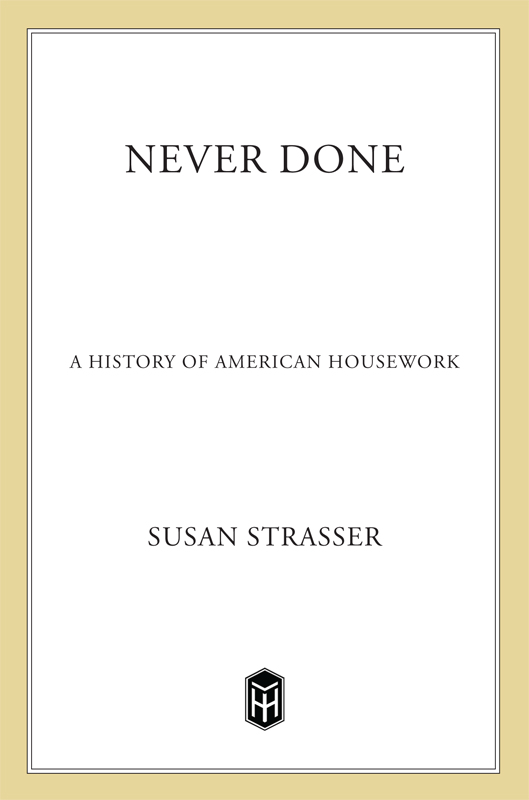
The author and publisher have provided this e-book to you for your personal use only. You may not make this e-book publicly available in any way. Copyright infringement is against the law. If you believe the copy of this e-book you are reading infringes on the authors copyright, please notify the publisher at: us.macmillanusa.com/piracy.
Contents
.
.
.
.
.
.
.
.
.
.
.
.
.
.
.
.
To the memory of my mother, Maxine Harriet Hochberg Strasser, and of the millions of other women whose work motivated my own
Preface
Never Done was originally published in 1982, an early contribution to what has become an extensive literature on domestic history and material culture. At the time I set out to study household technology and ideas about housework, housewives seemed unfit subjects for professional historical investigation. There were hopeful signs, however. The womens liberation movement had generated interest in womens history, at first outside a resistant historical profession, eventually within it as well. Advocates of a new social history were writing history from the bottom up, telling the story of everyday life in the past from the point of view of the many rather than the privileged few. Social historians had begun to study women who worked in textile mills before the Civil War, sewed in the sweatshops of the late nineteenth century, and entered the twentieth-century labor force as clerical and sales workers. Cultural historians were examining the popular ideology that had defined womens roles and established the notion that their place was in the home. Still, few studied housework itself, the major activity of half the population. Housewives remained hidden from history.
Yet their contributions could not have been more central. The household was once a center of production, where women spun, wove, and sewed raw fibers into apparel, and converted unprocessed plant and animal matter into meals. As most of the labor of making food, shelter, and clothing moved to factories, the women who kept house continued to work hard sending wage earners out to the worldcooking food over coal and wood fires, sewing garments with machine-made fabrics, and scrubbing clothes on washboards using homemade soap. Mass production, mass distribution, and the creation of a national market eventually brought new technologies to American homes, contributing to a redefinition of housework and of the broader relationship between the home and the economy. The fundamental tasks that remained in the homecooking, cleaning, the physical care of small children, and the emotional care of both children and adultsnow formed the core of new conceptions of housework. By the time Never Done was published, much of this work, too, was being fulfilled by commodities and profit-making services.
Indeed, the history of American housework is, in essence, the history of American industrialization and its transformative effects on peoples daily life. The story of the work done by housewives and domestic servants cannot be separated from the broader social and economic history of the United States. The family was part and parcel of society, not a separate institution vulnerable to the ravages of the industrialization process, nor did it react in some predictable Newtonian fashion to economic and political forces. Indeed, the idea that changes in family life can be seen separately from transformations in business and government is itself a legacy of the nineteenth-century doctrine of separate spheres for men and women. Similarly, theoretical constructs about technology and social change suggest neat causal statements about technology freeing women from the home. In fact, the technological transformation of housework took place alongside many other developments in economic and social life of consequence to women: new ideas about womens roles, new opportunities for women in new sectors of the economy, and general economic change.
It is easy to romanticize the past and impose modern conceptions on it, like two women I once heard commenting on the simplicity of an eighteenth-century kitchen at the Smithsonian. Clearly, they did not comprehend the immense labor of hauling water and building fires that was required in the absence of sink and stove. As I worked on this book, I came to understand my task as the exercise of historical correction and imagination. Until the last decades of the nineteenth century, most women labored without modern conveniences. Even some who could afford occasional domestic help had to carry water from wells, streams, and urban hydrants, and haul fuel for their cookstoves. Women who had indoor plumbing still hung laundry up to dry and sewed by lamplight. I countered my own romanticism by immersing myself in real womens lives and pondering what their work was like. At the same time, I understood that generalizations extrapolated from limited amounts of evidence to large numbers of people are bound not to correspond to any one womans experience.
Patent records, a traditional source for the history of technology, were of little use because I wanted to know when things became commonplace, not when they were invented. Other sources proved more fruitful. During the twentieth century, reformers, charitable organizations, government agencies, sociologists, and eventually market researchers conducted surveys of American consumption habits. Advertisements offered another kind of perspective on household products; with due attention to what advertisers call the target audience, the historian can uncover attitudes both about the new goods and the older methods and equipment they were intended to replace.
Neither consumption statistics nor national advertising existed before the end of the nineteenth century, however. For the earlier period, I relied on secondary works by others who had researched particular aspects of social and economic development, and on several major categories of primary sources. Mail order catalogues tell what consumers could buy; those from Sears and Montgomery Ward tell more than most because, as the first nationwide mass distributors, they tried to sell nearly everything and to attract customers from all classes except the very wealthy. Travel accounts written by visiting Europeans, a popular form of literature on both sides of the Atlantic when the United States was young, describe places, objects, and customs that Americans took for granted; Frances Trollopes Domestic Manners of the Americans describes household life in more detail than other such accounts because the author set up housekeeping in Cincinnati for about two years. Novels depict domestic scenes less explicitlya phrase here or there hints at attitudes about chores or illuminates the corner of a room; the ones written by women, especially Harriet Beecher Stowe and Louisa May Alcott, yield the most information. Direct testimony from housewives diaries and letters provides persuasive illustration for the generalizations of social history.
I continually returned to the literature of advice: cookbooks, womens magazines, and manuals for running households, which suggest ways of doing housework, give information about equipment, and counsel women on how to think about their work. These texts addressed a limited audience, especially in the earlier period when books and magazines cost a great deal of money, but women exchanged magazines, saved reference books for years, and passed on information and advice about housework to friends and daughters. Harriet Beecher Stowes sister Catharine Beecher wrote the most comprehensive manuals, framing her suggestions with a coherent theory about womens place and the function of womens work and revising them repeatedly over four decades, as household technology and middle-class expectations changed. Beechers books and the other advice literature convey an ideology about housework, a set of doctrines about womens work to analyze in conjunction with information about technological change and economic development.














